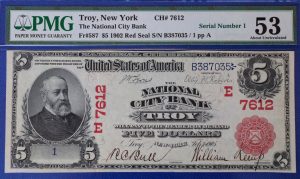Duncan Crary sent along an interesting little bit regarding the re-opening of a local rare coin shop that will also feature an exhibit of currency that was issued in the Capital Region back when that was a thing. Ferris Coin, which has been around since 1930, is reopening at 199 Wolf Road, and will feature a small exhibit of “Capital Region Currency: A History of Money in America” from Nov. 1 through Nov. 22.
 Ferris’s release says that the most notable note (sorry) is this one, a $5 bill issued by the National City Bank of Troy. They point out that one of the signatures, that of the bank’s cashier, is by Rice C. Bull, who was wounded at the Battle of Chancellorsville. His diary and letters were edited into a 1977 work, “Soldiering: The Civil War Diary of Rice C. Bull.” But the other signature is worthy of note too, that of William Kemp.
Ferris’s release says that the most notable note (sorry) is this one, a $5 bill issued by the National City Bank of Troy. They point out that one of the signatures, that of the bank’s cashier, is by Rice C. Bull, who was wounded at the Battle of Chancellorsville. His diary and letters were edited into a 1977 work, “Soldiering: The Civil War Diary of Rice C. Bull.” But the other signature is worthy of note too, that of William Kemp.
The National City Bank of Troy, according to an Oct. 23, 1957 article in The Saratogian, was then Troy’s largest national bank, chartered by the U.S. Treasury Department and having begun business on March 1, 1905 at the corner of State and First Streets in Troy. (Multiple sources put the start of the bank at 1905; the bill above is the 1902 series. We don’t know how to reconcile that.) By 1957, it was located at State and Third, and it was opening a branch in the brand new Latham Corners Shopping Center, moving fro a previous location on New Loudon Road. The bank also had locations in Cohoes (where it had taken over the Manufacturers Bank of Cohoes), Ticonderoga (merged with the Ticonderoga National Bank) and Port Henry (Citizens National Bank of Port Henry). Its building at State and Third still stands, now a branch of Bank of America, catercorner from Barker Park. Around 1924 the bank bought a building that had been the Arba Read Steamer Co. No. 1 and headquarters of the chief of the Troy Fire Department, as well as the old Second Precinct police station and police court. When the fire and police headquarters were moved to State at 6th, the old building was demolished and the new building erected. The cornerstone was laid in September 1926, with the building officially opening in September 1927. It had “a room set apart and suitably fitted for the use of the women customers of the bank.” In 1930, the United National Bank (northwest corner of State and First) merged with National City. In 1947, the bank acquired a local industrial bank called Troy Prudential Association at 251 Broadway. In 1948, it acquired the Manufacturers Bank of Cohoes.
In 1959, National City Bank of Troy merged with the State Bank of Albany, forming one of the largest banks in the state outside of New York City, with 20 banking offices. Once that happened, it went by the State Bank of Albany name.
William Kemp was its first president, 1905-1907. He had previously been Mayor of Troy, from 1873-75. He was also president of the Troy Brass Foundry (2129-2137 6th Avenue), of the J.B. Carr Chain Works, and of the Troy and Lansingburgh street railroad, and vice president of the Troy Gas Co. and the Troy Citizens Line. His banking gig was his last. He retired in January 1907 and died Aug. 14, 1908.
At the time of his death, he owned a home he had built at 65 Second Street. The Troy Record in 1954 reported that it had been designed by Stanford White and built for $85,000 around the turn of the century. Reports were that White was a family friend; a brokerage by the name of William Kemp shows up in the scandals surrounding White, but it wouldn’t appear that this particular William was associated with that firm. The house still stands, tucked in between the Hart-Cluett Mansion and a Sage College dormitory.
So why was the National City Bank issuing national currency? Well, in 1863 the United States Congress established the national banking system, and authorized the Treasury Department to oversee the issuance of national banknotes, charter and regulate national banks and authorize them to issue national currency secured by the purchase of United States bonds. The national banknotes were redeemable at any national bank. The system remained in place until the Federal Reserve Act of 1913 established the Federal Reserve Board, which then began issuance of Federal Reserve notes.
Ferris Coin has posted pictures of the currency that will be on display; you can see it here.

Leave a Reply